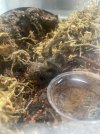bbyaya
New Member
- Messages
- 7
- Location
- california
Hello this is my first time posting so I’m not sure if Im posting on the correct forum. I’ve had my Singapore blue for 3-4 weeks and was told that it was around 5 months. Its had no problems with feeding or molting and just this morning was walking around the walls of the cage. I left to run errands and when I came back, it wasn’t moving at all and the more I touched the more it curled into the death curl  I had the blue next to my older (1-2 years) Costa Rican zebra male and was wondering if whatever affected the Singapore blue can affect the zebra? Or was it bad that I had the two cages in close proximity?
I had the blue next to my older (1-2 years) Costa Rican zebra male and was wondering if whatever affected the Singapore blue can affect the zebra? Or was it bad that I had the two cages in close proximity?
